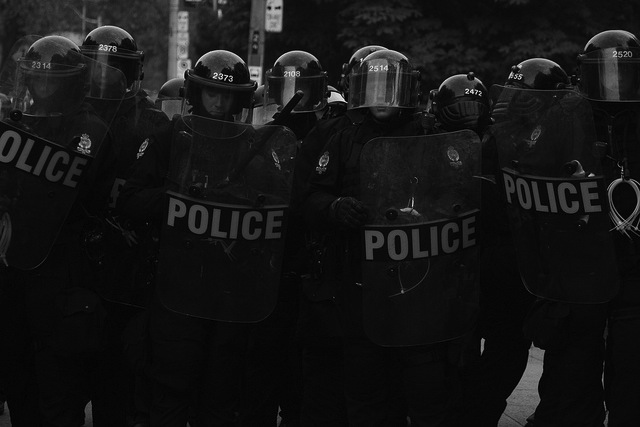Like this article? rabble is reader-supported journalism. Chip in to keep stories like these coming.
Within hours of the shooting of 18 year old Sammy Yatim on a Toronto streetcar in July of 2013, people were in the streets, outraged at the death of yet another person in crisis at the hands of the police.
Arguably, that outpouring of anger played a role in the Special Investigation Unit’s decision to charge the man who shot Yatim, Constable James Forcillo, with second-degree murder. Community mobilization was doubtlessly also a factor behind the long-awaited independent investigation into the use of force in such circumstances commissioned by the Toronto police, resulting in the Iacobucci report on Police Encounters with People in Crisis.
And it may well be that the public profile of Yatim’s death helped ensure that Forcillo actually went to trial, the first Ontario police officer ever to proceed to trial on a murder charge.
Yet last week’s jury verdict inspired no further protest. Although a jury had found a police officer acting in the line of duty guilty of a criminal offence, the overwhelming response was one of confusion.
Forcillo was found not guilty of second-degree murder and manslaughter but guilty of attempted murder. Sammy Yatim was dead, the officer who shot him guilty of… an attempt?
Adding to the confusion was Forcillo’s motion for a stay of proceedings brought right after the jury’s verdict, a motion that allowed his lawyer and the police union to argue that Forcillo may have been found guilty (by the jury), but that he hadn’t been convicted (by the judge) — and perhaps most importantly, a motion that allowed him to walk out of the courthouse despite the mandatory minimum sentence of four years for attempted murder with a firearm (five years if Forcillo’s gun is found to be a restricted firearm).
Within the hours of the jury’s verdict, lawyers and other experts had provided explanations for some of the day’s perplexing results.
The attempted murder charge had been a late addition by prosecutors, added only after the autopsy results indicated that the first set of bullets fired by Forcillo had actually killed Yatim. The charge of attempted murder related to the second set of shots, fired as Yatim already lay dying. The Crown Attorney’s late-hour gambit had proved prescient. Splitting the shots fired into two sets had given the jury options; even if they found the first set of shots justified they could still find Forcillo culpable for the second set — and it appears that they did.
A week later, we can draw some lessons from the trial and verdict for both the developments to come in this case and police accountability more broadly.
1. Police accountability doesn’t end when the jury goes home
It is impossible to know for sure if the jury was confused or conflicted, whether the verdict was a compromise or consensus. Nor is there consensus on how activists and others concerned with police accountability, particularly within marginalized communities that bear the brunt of police misconduct, should respond to the verdict.
Arguably it was both a victory and a defeat, but one that reinforces the centrality of community mobilizing and reminds us that the struggle for police accountability — and deeper policing reforms — is neither linear nor unanimous.
2. The police are fallible — and not just in the courts
Before trial, Forcillo’s lawyer Peter Brauti had made an unsuccessful change of venue motion, arguing that his client couldn’t get a fair trial in Toronto. Once the trial began, Brauti attempted to mount a “suicide by police” defence, seeking to convince the jury that a despondent Yatim had sought to provoke police into killing him. After the jury’s verdict, he claimed — contrary to research demonstrating the opposite — that police who testify in court are seen as less credible in court.
All of these legal machinations point not to justice system benevolence but the fruits of decades of concerted organizing in response to police violence.
3. The Charter makes for strange bedfellows
One of the components of Forcillo’s stay motion is a constitutional challenge to the mandatory minimum sentence for firearms offences. Justice Then won’t hear the motion until late May, and whatever his decision, it likely won’t be the end of this case.
There is a deep irony in a police officer using the Charter to fight mandatory minimums — police associations have always been key advocates for such tough on crime justice policy, all evidence against the utility of mandatory minimums be damned — but Forcillo’s motion may be well-timed. The Supreme Court has issued several mixed rulings on mandatory minimums and heard a case on mandatory minimums in drug sentencing just last month and sentence reforms are part of Attorney General Jody Wilson-Raybould’s Mandate Letter from the PM. If the punitive tide is turning, Forcillo may be along for the ride.
4. The courts won’t set this precedent alone
Whatever the result in May — and beyond — Forcillo’s prosecution undoubtedly set legal precedent, adding to the already complex frameworks governing police actions in similar circumstances and particularly questions of reasonableness with respect to fear, threat assessment, and especially, use of force. That precedent is far from clear however, and policing reformers and activists should be wary of attempts to construe the jury’s verdict as justification for Forcillo’s actions — or in police interactions to come.
The death of Sammy Yatim continues to reverberate, most visibly in the criminal and civil courts and as the Iacobucci recommendations are implemented, but other impacts remain open, defined not by the law but by the political demands we make of police — in practice and policy.
Based in Vancouver (unceded Coast Salish Territories), Irina Ceric is a faculty member in the Criminology Department of Kwantlen Polytechnic University, as a well as a longtime activist and formal criminal defence lawyer. Twitter: @irinaceric
Photo: flickr/ katerkate



